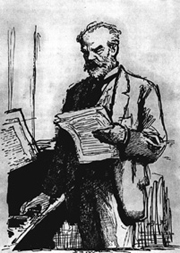Trivia
Cello masterpieces: Concertos II
Many of the cello concertos composed in the 19th century that are still popular today were written by composers who were not, themselves, cellists. The image of the cello playing rolling melodies against a massive orchestra may have had its origins in the concertos of the romanticists.
P. Tchaikovsky: Variations on a Rococo Theme, Op. 33
Tchaikovsky wrote this piece for Wilhelm Fitzenhagen, a friend from his student days and a cellist. Although Tchaikovsky received some advice from Fitzenhagen in composing the piece, the cellist later modified it without Tchaikovsky's permission, and it is this modified version that is generally played today. In this variation the poetic sentiment of the cello and masterful performances unfold, under a main theme that is based on the rococo style that was popular in the middle of the 18th century. Recent performances have followed Tchaikovsky's original version, allowing the audience to gain an appreciation for how the music was originally composed.
A. Dvorak: Cello Concerto in B minor, Op. 104
This is perhaps the most famous cello concerto. Dvorak began writing this concerto after speaking with a friend from his time at Prague Conservatory, Hanus Wihan, who was a cellist. However, the piece was not finished until 1895 when Dvorak was in New York. The piece was first performed in London the following year, but the cello solo was played by Leo Stern. Touching on such sources as folk music from his native Bohemia and black spiritual music, the entire concerto unreservedly expresses the beautiful melodies characteristic of Dvorak.

Antonin Dvorak
Musical Instrument Guide : Violin Contents
Origins
Structure
How to Play
How the Instrument is Made
Choosing an Instrument
Care and Maintenance
Trivia
- The f-hole used to be a C-hole or S-hole
- Why the f-hole?
- Violinists must bow to the horse
- Steel strings or gut strings? That is the question
- Is the chinrest the unsung hero of the violin?
- Most violin varnishes are also medicines
- Violin masterpieces: Solos I
- Violin masterpieces: Solos II
- Violin masterpieces: Solos III
- Violin masterpieces: Concertos I
- Violin masterpieces: Concertos II
- Viola masterpieces: Chamber music
- Viola masterpieces: Concertos
- Cello masterpieces: Concertos I
- Cello masterpieces: Concertos II
- Cello masterpieces: Solos
- Contrabass masterpieces: Concertos
- Contrabass masterpieces: Chamber music
- Orchestral masterpieces featuring the contrabass
- What do you call the part on the bow that you hold?
